burnt orange is NOT my favorite color, but that doesn't mean it isn't good art...
a large knitted piece hanging in Cologne's Museum Ludwig offered me an intriguing opportunity to find out...
here she is, hanging in the Museum Ludwig...
not far from Yan Pei-Ming's Portrait of Mao...
whaddya think...?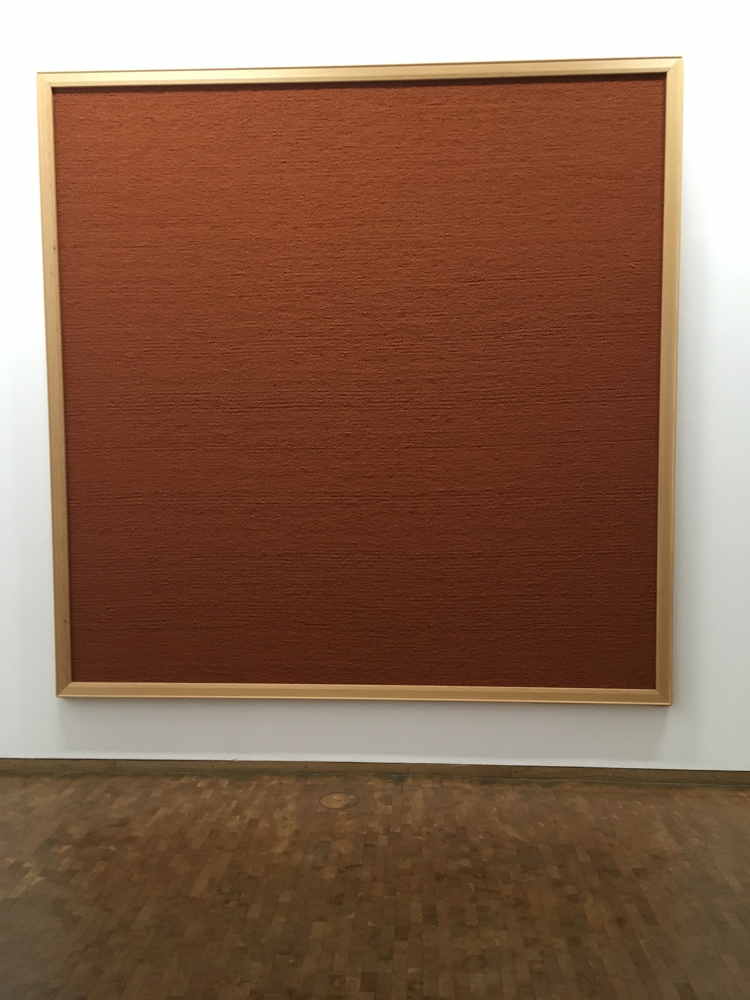
🎶 kristo’s bongo theme 🎶
hey, it’s kristo.art...
welcome back...
In this episode
you know what...?
wait, wait, wait....
just a sec...
this is, indeed, kristo.art...
and I sure do love my bongo intro theme...
but somehow it doesn’t really fit the piece I’m gonna be talking about today in this 2 part episode...
(* which actually turned into a 3 part episode)
something about it gives me the feel of a space where people kinda like having hootenannies...
so I found some music that’s a little bit closer to that feeling and my first impression of the piece...
🎶 Thorn & Shout: “Farewell” 🎶
yeah, that’s it...
that’s better...
alright...
let’s get back to this...
Welcome back...
In this episode I’m back in Cologne’s Museum Ludwig and I’m looking at a piece I couldn’t help but notice, since it hangs in the same space as Yan Pei-Ming’s portrait of Mao, and it’s nearly as large...
I have to admit that it really stood out for me because my first impression of it was that I disliked it pretty intensely.
As I’ve said, first impressions are perfectly valid, of course—but only as first impressions...
and as I said in my last episode, Part 2 of the Portrait of Mao,
they’re not necessarily correct...or worth holding onto...
and by definition, they don’t qualify as considered opinions...
which is what we’re after in contemplating images in a museum or gallery...
in any case, the stronger they are—those impressions—positive or negative, the more we should value the image that triggered them...
not as an object in itself...
but as a mirror to some valuable part of ourselves that we’ve lost track of...
something that only our intuition recognizes...
and that makes them a very handy key to greater self-knowledge...
or maybe I should say a handy shovel to that end...
because digging deeper into the thoughts that lie beneath and beyond those shallow first impressions is what our intuition requires of us...
and the hard work is really all the digging and thinking...
which just means it takes real patience to stand there and keep looking closely at an image...
and thinking deeply about what we’re seeing...
without even knowing what we SHOULD be thinking...
sometimes I think that contemplation is all just a matter of fighting the urge to give up looking and trusting that whatever thoughts come up from within are going to teach us something valuable...
you can think of intuition as a metal detector or a geiger counter...
it tells us where to start digging for buried treasure...or uranium...
or even nuclear waste...
and unfortunately, it’s true that some things are better left buried and undisturbed...
but for introverts like me, it’s just about impossible to ignore the siren call of intuition...
especially where art is concerned...
okay... let’s get this party started...
🎶 Thorn & Shout: “Farewell” 🎶
In the Museum Ludwig:
@03:27
So I’m standing in front of another abstract piece that I’ve thought about quite a bit since looking at Mao
and the only reason I’ve thought about it is because it’s here, and because I had looked a little bit closer to it
and was repelled by it...!
I’m still kinda repelled by it
but only for the reason that I don’t like the color
it’s a color that has a really negative effect on my psyche…
it’s sort of a brick red with a little bit more yellow in it...
a kind of burnt orange...
and in the box of crayolas, one of the colors that I really detested—burnt orange...
it had a feeling about it that was really unpleasant
🎶 “I don’t really care how you feel” 🎶
and that’s the deal with color, very often
that it's all about the feeling...
at least for me...
and that's probably true for a lot of INFPs
🎶 “really” 🎶
well, yeah...
So, what's an INFP, you ask...
@04:29
For those of you unfamiliar with those initials:
INFP is a reference to Jungian Typology as it was elaborated on by the Meyers-Briggs mother daughter team...
it’s more popularly known as a personality type...
but it’s actually based on the historic concept of temperament...
and temperament corresponds to the ancient theory of the humors, such as sanguine, or choleric, or even the melancholic, for instance...
It’s actually a very important concept, but I’m not going to go into that here...
I’ll leave you a good typology link for further reading in the show notes...
and maybe I’ll even do a podcast on it at some point...
but for now, just let me say that:
I stands for Introverted—as opposed to E for extraverted...
N stands for Intuitive—as opposed to S for Sensation...
and people who classify as Sensation types tend to be more literal minded than us Intuitive types...
Sensation types have the attitude associated with Missouri: the self-proclaimed “Show Me” State...
the most famous example of an S type in art was Gustav Courbet,
who famously said something to the effect that he would only paint an angel if someone could point one out to him on the street...
F stands for Feeling—as opposed to T for Thinking...
and we Feeling types judge things according to how they make us feel,
whereas Thinking types prefer to remain unemotional about choices...
(think of Mr. Spock as the poster child for this)
P stands for Perception...
and it’s opposite is J for Judgment...
the words are actually kind of confusing,
but the behavior they drive is easy-peasy to observe...
that is to say, Ps, like me—we prefer to keep our options open...
we’d just rather not have to make or agree to plans way in advance...
and that makes J types think we’re non-committal...
even kinda flaky...
you can always recognize a J type...
they’re the ones who pull out the calendar on January 1st and start planning out their year...
they also wish everyone else would stick to the plan as well...
and not be so difficult to pin down...
(*this is a really detailed explanation for INFPs...
but I also think it's TMI
here it is, though...)
if I’ve confused you with that little detour into the back roads of Jungian Typology,
don’t worry, I’ll get us back on the highway of this burnt orange artwork...
it’s just that in order to get there, I don’t know any shortcuts,
so I guess we’re gonna have to take the scenic route...
just brace yourself for that first part...
the ruts are awfully deep...
I promise though, the rest of the ride will be pretty smooth and involve plenty of interesting local color...
🎶 car bouncing along on a dirt road 🎶
a little color psychology...
@07:25
according to Wikipedia: “color psychology is the study of hues as a determinant of human behavior.”
(* here is a much better resource on the subject...)
so you can imagine, there are plenty of resources around the web describing how you too can use color psychology to increase the sales of whatever you’re out there hawking...
all of those websites take a kind of extraverted stance,
meaning: what’s the effect of YOUR color choices on other people...
but I haven’t seen anything describing color from the perspective of the introvert...
how we tend to think about color from the inside out...
meaning: why do I choose a particular color in the first place...?
—as an utterly personal choice—
not as a means to manipulate or persuade someone else...
I don’t care how other people feel about a color choice that I make for myself...
I’m interested in exploring how I feel about it...
what it says to me, what it makes me think of...
I’m sure that graphic artists and designers have a great handle on how most people feel about specific colors and color combinations...
but I very much doubt that most painters or fine artists choose their colors based on how other people might respond to or think of them...
I spent quite a few years reading Carl Jung...
and I always felt like I couldn’t read him without using colored pencils...
🎶 “huh?” 🎶
actually, I started out borrowing Jung’s books from the library,
but, then I realized that because I needed to mark them up, I had to start buying them for myself...
which is what I ended up doing...
So I’d underline sentences I considered important, and sometimes make little doodles next to the ones that really spoke to me...
and I would choose colors to express the different levels of personal connection to the material...
almost like a heart or love emoji vs. a simple thumbs up or like...
[* this is an aside that I didn't add in the podcast...
feel free to skip ahead, though...
we INFPs may be Introverted,
but we're not shy about expressing our views...
not once we get talking, that is]
* I never liked using highlighter pens because there was no nuance to them...
and because I’m just no good at summarizing things—like picking out the one or two key elements in a long text...
I might highlight 6 or 7 sentences on a page, but they usually don’t all have the same importance to me...
so instead of using the few different colors of those bulky, highlighter pens, colored pencils allowed me to give different thoughts on the page a kind of emotional hierarchy...
and with their greater range of available colors, colored pencils allowed me to use color as a kind of abstract emoji...
which, in a way, is how I tend to understand an artist’s use of color...*
here's an example of the way I read Jung:

color felt like a kind of glue...
so that with it I was cementing, or at least just acknowledging, a fervent bond between myself and what I was reading...
that said...
with this burnt orange piece on the wall,
my first impression was to emotionally distance myself from it...
to deny any bond with it...
but you see, hating a color, an art work or anything, actually, isn’t distancing yourself from it...
just the opposite...
and so my intuition was telling me I should carry on and keep digging a little deeper...
Meanwhile, back in the Museum...
@09:50
but this is a big piece...
it's not as big as Yan Pei-Ming’s pieces...
it's fairly tall, probably the realm of like 10 feet tall...
8 feet tall...
and it's a square.
so, I'm not sure what the dimensions are,
but it's surrounded by a very specific—
simple, but specific wooden frame...
and it is all of one color...
and I know from having gotten close to it that I think it's something of a weaving of sorts...
or a knit.
it's like somebody took a knit blanket and stretched it out as if it were a canvas...
so it has a lot of texture to it because it is in fact fabric of some sort.
so when you're standing far away from it you get a sense of shadow—
shadow and texture, as if it could've been a painting—
as if there's a tremendous variance in the way the light hits it.
so there are shadows everywhere as if they were brushstrokes.
🎶 Thorn & Shout “Farewell” 🎶
so getting up close to it, or closer to it, because there's issues with guards—
museum guards, naturally—
but it looks like some kind of interwoven knit of some sort.
it's like a lock stitch of some kind...
the kind you do with macramé, or I don’t know what.
I really don't know what the the process is...
but it's like wool.
🎶 “mind the gap” 🎶
Fusilli...???
@11:38
well, the material may actually be wool, but I can’t help noticing that the chains of yarn—
they remind me more of pasta than a sweater or a blanket...
since that’s what this whole thing kinda looks like:
a big stretched out blanket mounted on the wall...
like something my mother might have made...
and being Italian, she sure made plenty of pasta...
for the record, having grown up in NYC, the brand name we always had was Ronzoni,
and the particular pasta shape was called fusilli...
Ronzoni no longer makes that shape...
and what most companies now call fusilli, is really something completely different...
anyway, I really liked fusilli...
but that didn’t make me like this piece any more...
something about those earth tones...
I’m just not an earth tones kinda guy...
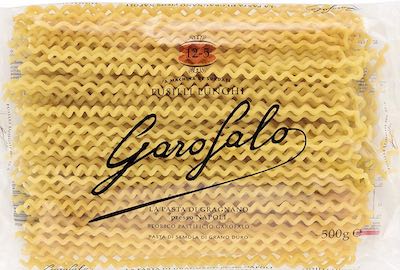
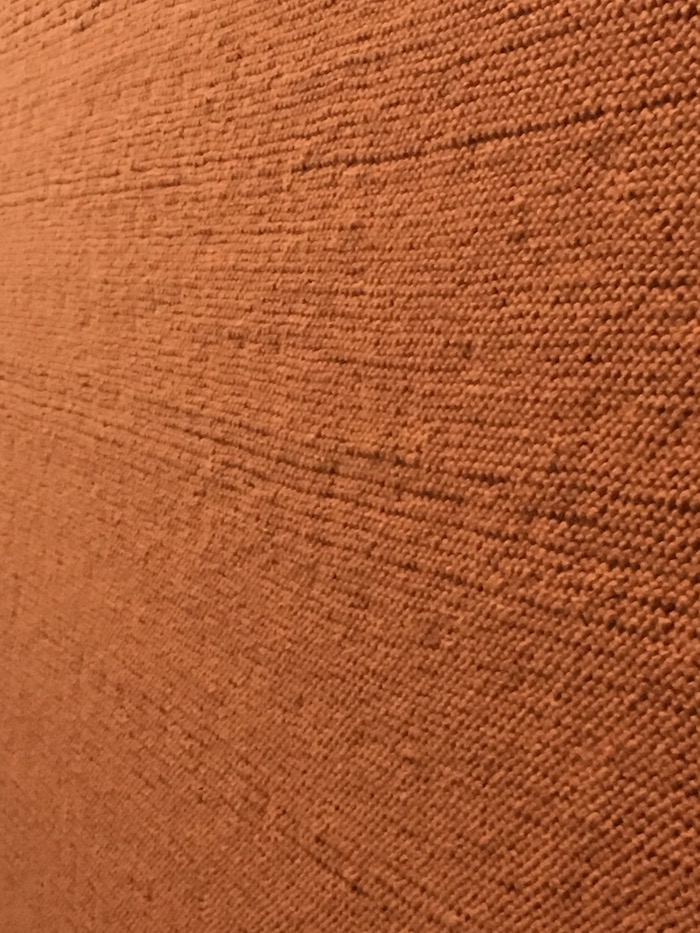
🎶 “mind the gap” 🎶
it's yarn, essentially, that's been knitted...
the chains of yarn go horizontally
so the shadows are horizontal.
of course there's also in between these chain links—there’s shadow...
but the overall effect is as if someone had—
well, from a distance—
somebody had painted this...
but up close, obviously, it's a sort of artsy-craftsy kind of piece.
now I want to get really close to see what's behind this thing in terms of the background of it...
but I want to be careful of the guard...
so let's just get close.
🎶 Thorn & Shout “Farewell” 🎶
Museum guards...
@13:19
so this museum guard thing is a personal semi-peeve...
so just indulge me here for a sec...
🎶 “alright folks” 🎶
I get it...
all of this expensive art has got to be guarded...
first of all against outright vandalism:
(like that nutcase who took a hammer to Michelangelo’s Pieta back in 1972, for instance)...
but also against the clumsiness of visitors...
especially the ones taking selfies...
I think we’re all aware that there’s a growing list of some very expensive museum-selfie bloopers showing up on social media and in the news...
🎶 “it’s really terrible” 🎶
so sure...
that’s why they’ve got guards...
and it’s why they have those little strips of tape on the floor...
sometimes even little barriers...
they’re usually about 18 inches out in front of most pieces...and they’re just meant to serve as polite reminders of a line you’re not supposed to cross...
🎶 “no, no, no that’s very bad” 🎶
so I have to admit having crossed the line plenty of times, especially with paintings...
and not just because I’m mostly near-sighted...
I don’t touch them...
I just need to see them from the same distance as the artist who painted them...
one particularly memorable time was in Rome in 2001...
I happened to be there while some amazing exhibit of Caravaggios was going on...
I remember seeing it advertised on the side of a bus, and I immediately knew—I had to go...
🎶 “oh yeah” 🎶
so when I saw the title of the exhibit—
which essentially came off as “come and touch some Caravaggios”—
it made my heart skip a beat...
🎶 “wowowow” 🎶
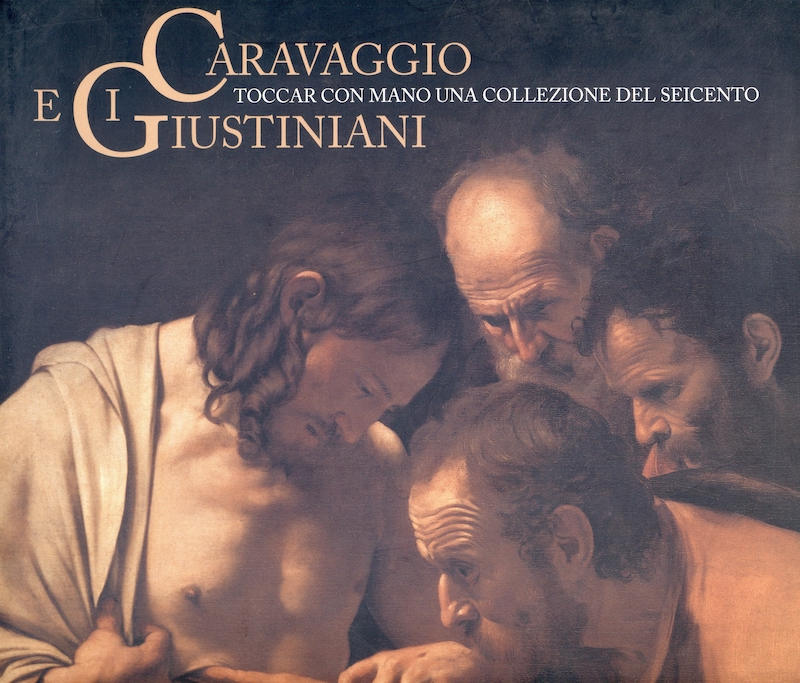
you just have to know that in the history of Western European painting, Caravaggio is one of the most interesting, innovative and influential painters who ever lived...
you also have to know that there aren’t very many Caravaggios left in the world...
outside of Rome, they’re distributed pretty randomly in cities like Bergamo, Potsdam and St. Petersburg...
🎶 golf swing / golfer shouting "fore!" 🎶
no, no, no...
I didn’t mean that St. Pete’s...
I meant the other one...
you know...
the other one...?
🎶 russian "I love you” 🎶
so that was around 20 years ago...
but 10 years before that I’d been told that there were actually fewer than 50 Caravaggio’s left in the world—
and that there was only one in the US, in Kansas City, of all places...
🎶 “no way” 🎶
it’s now known there are closer to 80 or 90 Caravaggio’s, and there are about 9 or 10 in the US...
[* this number, taken from wikipedia, may actually be wrong...
after recording this episode I read a much more credible (and super-interesting) source saying that there may only be about 66 of them]
but there still aren’t any in Chicago...
which is where I was living when I had to decide on a destination for one of the art road trips I loved taking back in the 90s...
It was a 4th of July weekend, and the choice was between Kansas City, with it’s one Caravaggio, and Memphis, with it’s one and only, Graceland...
having to choose between a hallowed shrine to Baroque art and a hallowed shrine to Elvis and Kitsch...
Well, I chose Kitsch...
🎶 audience saying "yes!, yes!” 🎶
and I had a great trip...
a few years later I actually even got to KC and I saw the Caravaggio...
but that’s another story...
now, one of the things Caravaggio is most famous for is his chiaroscuro...
🎶“huh?” 🎶
which is just the stark contrast between lights and darks that he puts into most of his images...
I mean, if you ask me, the guy is actually really famous for painting darkness—
since it covers more than half of most of his canvases...
sure, he’ll have some subjects wearing a white article of clothing...
but every one of his paintings depicts a scene that’s taking place either in a very dark room or very late in the day...
and if you look at reproductions of these paintings, what you see is just lots and lots darkness...
but you don’t really think all that much about it...
except to say, maybe, oh yeah—that’s his chiaroscuro...
but really...
you know...
people don’t talk about his shadows so much...
instead, they kinda talk about how his subjects are peasants with dirty fingernails and dirty feet...
🎶 a disgusted “well then” 🎶
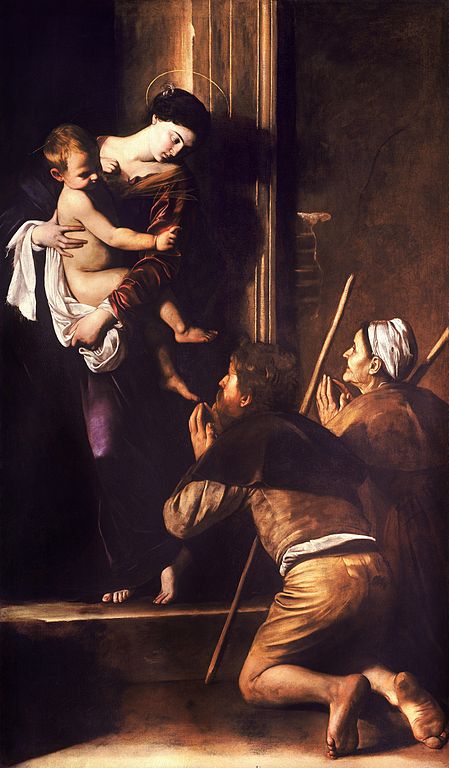
Caravaggio's Madonna di Loreto
so, what’s there to see in a shadow...?
I mean, when you’re looking, you don’t really pay so much attention to the shadows except maybe as a visual device...
or even a kind of visual trick...
intellectually, you can understand that all of that darkness makes anything lighter stand out more dramatically...
like stage lighting, when they put a spotlight on one single character while everything else is left dark or just barely lit...
🎶 “to be or not to be” from Hamlet act 3 scene 1 🎶
okay, so we know the guy is really famous for this dramatic lighting...
but still, there’s no way you can understand what’s so great about it from looking at reproductions...
even in person—looking at the huge paintings hanging in some of the churches around Rome—
they’re just too far away for you to see any details...
and just like the lighting in the compositions, they’re really poorly lit...
you have to dump some coins in a slot to get a minute’s worth of lighting...
but the lights might as well have been designed by Caravaggio himself...
🎶 “can you see it now” 🎶
but at this special exhibition, there were all of these very famous (and really awesome) Caravaggios...
all gathered in one place...
and while none of them were anywhere near as large as those famous altar pieces...
they were hung in such a way that you could get really, really close...
🎶 mind the gap 🎶
okay, so they didn’t let you actually touch them...
but you could lean in pretty far...
but only just so far...
as I found out, because I was the guy who kept setting off a buzzer every time I leaned in over the waist high rope they had set up in front of the paintings...
and every time I did it, a very pleasant guard reminded me that I was getting too close, again...
🎶 "hey, back off...!" 🎶
but I will never forget, that one of those times...
I was looking at this painting that normally hangs in the Hermitage, in St. Petersburg...
it’s called the Lute Player...
and on one side of the composition there’s a vase of flowers...
some of them have white petals...
and while I was looking at the detail of some of those petals, I couldn’t help but notice that the darkness between them—
the dark background that made them pop—
it wasn’t black...
and it wasn’t some dark muddy brown the way it looks in reproductions...
and it wasn’t just some anonymous shadow or dark, generic fill-in to make the light stand out...
it was alive, with color...
dark ones, to be sure...
but unbelievably complex and lively...
🎶 chicken & ducks 🎶
hey...not like that...!
he didn’t paint a barn...
how about some greenery, huh...?
🎶 birds in a forest 🎶
okay, yeah...
that’s more like it...
yeah...
but that’s more like morning...
how about something nightlike...
evening...
🎶 spring peepers 🎶
yeah...!
that’s it...!
peepers...!
spring peepers...
aaah...
I love them...
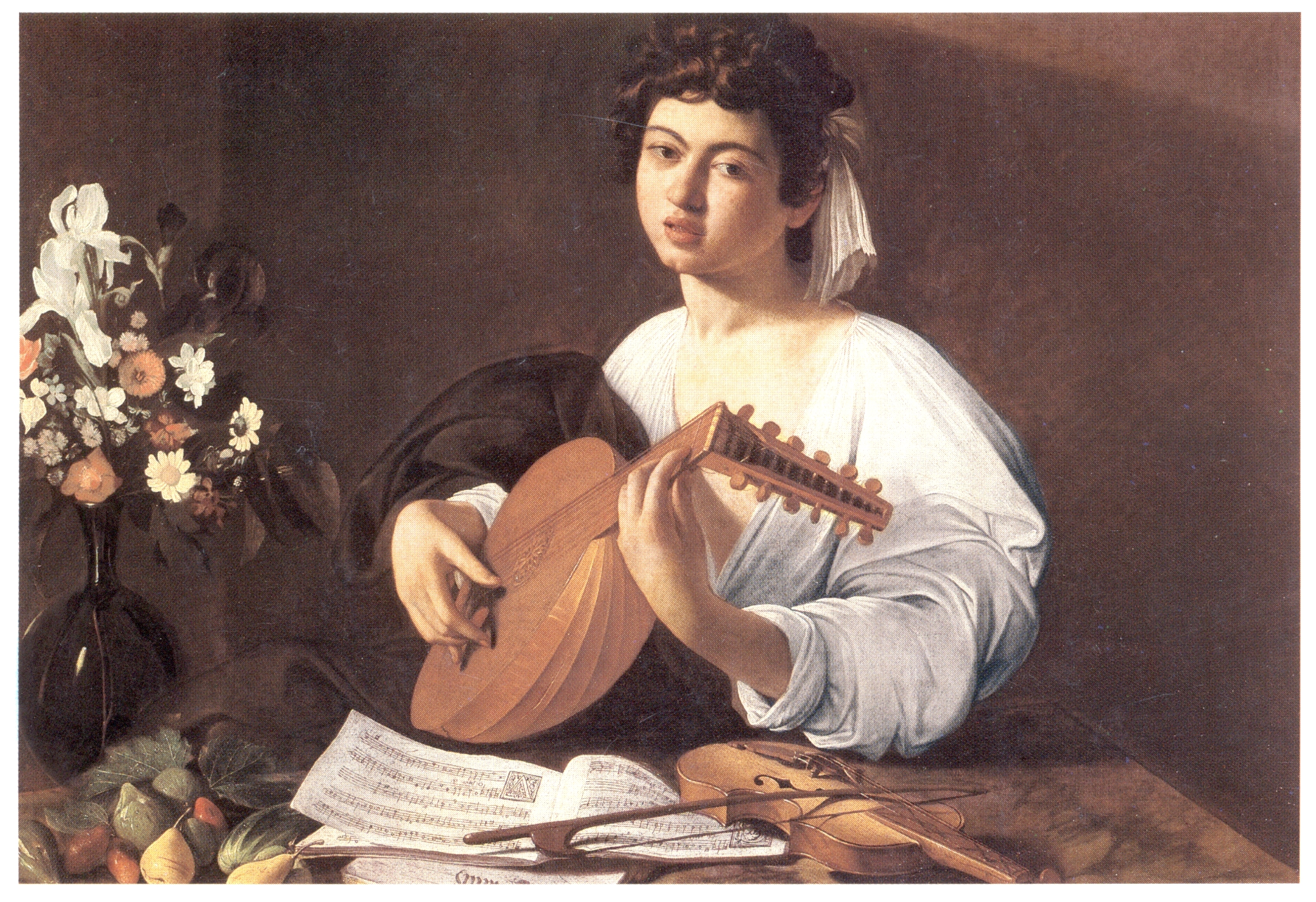
Caravaggio's Lute Player
if I could describe the experience,
I’d say it was like opening up an old wooden box in some poorly lit, stuffy attic,
and finding it filled with emeralds and rubies and garnets...
it made me gasp...
or, in the words of my all-time favorite art critic, John Berger:
"Occasionally there’s a vision which makes us both gasp — gasp as one does before a revelation."
🎶 "oh!" 🎶
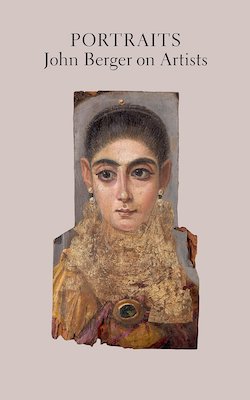
(*check out the 1 page Preface of Portraits, by John Berger for that quote...)
so normally, there’s no way to get up close and personal with those amazing images...
but there I was...
I was leaning in and all of a sudden seeing...
really seeing what was in all of that seemingly anonymous darkness he covers more than half of his canvases with...
so it turns out that getting up close is the only way to see deeply into and understand the power of what he’s most famous for:
his chiaroscuro...
and so, for the first and only time in my life, I got to see the amazing complexity that his scuro really, really is...
and just seeing and recognizing that was one of those ultra-miraculous moments that looking at art can bring...
it gives you an emotional jolt...
it can fill up your whole chest...
and not with pride...
but something else...
something I don’t even have words for...
🎶 "...it’s all complicated" 🎶
you see, this is amazing, because if I hadn’t started talking about museum guards, I never would have remembered that moment...
and that’s what intuition does for you...
right here and now, it brought back that experience...
it brought back that experience and the way I felt when I saw the breathtaking complexity of Caravaggio’s darkness...
the feeling was like looking at what it means to be completely yourself...
seriously!
it was like a feeling of absolution for all sins and shortcomings...
a kind of benediction...
🎶 Mass in Croatia 🎶
okay...
I’ll even call it a religious experience...
and this wasn’t even one of the religious paintings...
let’s just say I was deeply moved...
kinda like the way you sometimes felt as a kid...
when all was right with the world...
with your world...
when you were more than totally happy...
which is something that happens way too infrequently as an adult...
what’s weird, and maybe a little sad is that while you never forget experiences like that,
it’s still one of those memories you tend to forget about...
they kinda sit in the back of your consciousness closet until you have a reason to come across them again...
just like now, when I just remembered it for the sake of this podcast...
and through the most peculiar of memory prompts:
museum guards...
🎶 "roger that!" 🎶
anyway, there I was, I kept leaning in closer to those Caravaggios...
and I kept setting off alarms...
but the guard who kept having to warn me off...
he never gave me a hard time...
he was really, really kind and very gentle about it...
kinda like, he understood...
🎶 "yes, sir!" 🎶
and unfortunately, that experience was different from the one I had in this museum
—the Ludwig.
🎶 "hmm" 🎶
a guard warned me off getting vaguely close to their one large Rothko...
I had been trying to get close enough to really see what’s in Rothko’s amazing color fields...
and considering what you can find in Caravaggio’s incredible shadows, maybe it’s possible to see something very similar in Rothko...
I wasn’t thinking about Caravaggio at the time,
I was just looking with as open a mind as possible...
I was hoping to see just why I love Rothko’s work...
which I do...
but before I could get close enough to see anything and think it through I was just warned off—
very politely, but very emphatically...
And I have to admit that it pissed me off so badly I couldn’t think straight or contemplate what little I did see...
so I turned right around and I walked right out of the gallery space...
of course, I recognize that I was only having a kind of silent hissy fit...
I was acting out in some stupid passive aggressive way...
but that was better than trying to argue with the guard...
...not only because my German is so bad...
or even because she was only doing her job...
but very often museum guards must think I’m some kind of deranged character...
if only because, unlike the vast majority of museum visitors, I actually stand in front of a painting and look at it longer than the average 27 seconds...
(something I spoke about in Episode 1 when I introduced this kristo.art podcast...)
that 27 seconds...
it’s the going rate...
it seems ingrained in the culture of museum visitors...
when you see everybody else spending so little time looking at a painting—you just naturally feel self conscious...
conspicuous...
even a little vulnerable, if you don’t act the same way...
and that’s what the guards are used to seeing...
it’s what they can understand as appropriate museum behavior...
anything else, I think, makes them suspicious and antsy...
who knows, maybe even a little angry...
kind of like having someone stare at them...
🎶 “stop it!” 🎶
long before selfie clumsiness became a commonplace in museums, I would always find guards shadowing me...
if only because they were (and still are) so un-used to seeing people actually spend time looking at a single painting...
so while I’m used to guards acting suspicious of me...
it still feels annoying...
and feeling annoyed makes it that much harder to make space between my ears to think about the art...
for the record, I NEVER touch the art...!
🎶 “what, never?” 🎶
okay, so I did, once, actually touch one of Joseph Beuys’ Felt Suits...
hey, art is my religion, okay...?
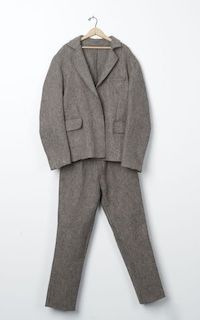
I swear I had actually been thinking of Matthew 9:20-22
20 And, behold, a woman, which was diseased with an issue of blood twelve years, came behind him, and touched the hem of his garment: 21 For she said within herself, If I may but touch his garment, I shall be whole. 22 But Jesus turned him about, and when he saw her, he said, Daughter, be of good comfort; thy faith hath made thee whole. And the woman was made whole from that hour.
okay, so I didn’t know chapter and verse...
or even remember the whole story—which actually involves a gynecologic problem...
and that, in itself, is a pretty wild synchronicity, considering my professional life as a gynecologist before diving headfirst into art...
it’s just that standing in front of that Josef Beuys piece I remembered some biblical incident involving someone touching the hem of Christ’s garment and wanting to be healed...
so I thought I’d take a wild leap of faith in art, and do one of those crazy bold actions that may draw some attention, but are really only meant to honor our dreams, synchronicities and intuition in general...
and because of that mostly unwanted attention, those are actions that we introverts usually shy away from doing...
🎶 sympathetic "ahh" 🎶
and I also did get warned off of getting too close to Yan Pei-Ming’s portrait of Mao...
but that was because my camera bag was dangling dangerously close to the painting...
and the guard was perfectly right in pointing out to me that I could probably get what I wanted by zooming in, instead of leaning in...
but it’s funny to think that I should get so worked up about museum guards as I did with that Rothko guard...
I recently read a short rant by none other than John Berger, who, in his book, Bento’s Sketchbook, let us all know that he was infuriated enough by the intransigence of a museum guard to actually drop an F-Bomb...
🎶 crowd gasp 🎶
so if John Berger can have a hissy fit...
well...
so can I...

okay...
rant over...
🎶 “enough rants / thank you" 🎶
Back in the museum...
@ 29:44
...and I'm looking but I don't quite...
I can't quite tell...
there's one space here where it seems to have been stretched a little bit...
was probably not meant to be...
although you’d suspect that when this thing was handled it was probably fingered at some poin...
maybe accidentally...
and so there's a little bit of a stretch between some of these things...
and it looks like plain old canvas stretched behind it, which is my guess...
it could be wood, but I don't think so because that would probably make it really heavy.
So this another one of those pieces where I would say:
Who the hell would want this in their living room?
to me it seems like the kind of art you would buy at Pier 1 or something
or whatever those places are...
it's decorative...
but it's not meant to be...
it has a feeling like the decorative business.
the sides interestingly enough are not covered...
so this yarn is stretched around the frame...
probably around a framed canvas...
and the frame, the wooden frame that's placed around it, is this blond wood...
kinda, sorta tasteful blond wood...
simply planed, carved whatever...
and it just has a feeling of like a 60s or, no, it’s more 70s to me...
a 70s decorative piece that would've hung in somebody's room who likes that color...
but it's a color I just can't take...
and yet it has a depth to it that doesn't necessarily draw me in but it beckons, like a question...
like saying okay, so what do you think?
what do you think you're seeing?
what are you— what is this bringing up in you?
🎶 Thorn & Shout: "Farewell" 🎶
Stay tuned for parts 2 & 3...
well, those are questions I’m gonna answer in part 2 of this episode...
for now, just let me say that even though my initial impression was to dislike this piece, I’m really grateful to it—and the artist—for reminding me of that Caravaggio experience...
but that was an indirect memory prompt and not something entirely intrinsic to the piece...
chances are, I’d have eventually remembered that miraculous moment in Rome without ever looking at that burnt orange blanket on the wall...
but in the weeks and months that followed this visit,
as I continued to think about what this piece of fiber art might have to say for itself...
not only to me, but to any of us willing to pay some close attention to it,
it did speak...
and said something so surprising, and so important, I was really impressed...
it was something that even made that Caravaggio reference less random...
and what it said not only makes this an extraordinary work of art, but one I’ll be very happy to visit over and over in the coming years...
so that’s what I’ll be talking about in Part 2 of this episode...the things that make this an extraordinary work of art...
in the meantime, check out my website for the show notes and transcripts of this episode...
you know: https://kristo.art/podcast
thanks for listening...
and don’t forget that while art is for everybody...
you have to keep looking for yourself...
that’s how you personalize any work of art and make it your own...
I guess it’s kinda like voting...
maybe you don’t feel so confident that your vote counts...
but I can tell you for sure that every minute you spend looking at and thinking about art makes a huge difference to your psyche, your intuition and your life...
yeah, I know...
that sounds a little cheesy...
but it’s something I truly believe...
give it a try for yourself...
ciao, a tutti...
got a question, a comment, or just wanna say hi...?
I'd love to hear from you...
Sound Credits:
Thorn & Shout: “Farewell”
"Farewell" by Thorn & Shout is licensed under a Attribution-Noncommercial-Share Alike 3.0 United States License.
“I don’t really care how you feel” courtesy of greenratt
This work is licensed under the Creative Commons 0 License.
"really...?" courtesy of juror2
This work is licensed under the Creative Commons 0 License.
"car bouncing on dirt road" : a mix courtesy of Robinhood76 and craigsmith
This work is licensed under the Attribution Noncommercial License.
"huh...?" courtesy of Adam_N
This work is licensed under the Creative Commons 0 License.
"mind the gap" courtesy of InspectorJ
This work is licensed under the Attribution License.
“alright folks” courtesy of ERH
This work is licensed under the Attribution License.
“it’s really terrible” courtesy of clivew
This work is licensed under the Creative Commons 0 License.
“no, no, no that’s very bad” courtesy of Greencouch
This work is licensed under the Attribution License.
“oh yeah” courtesy of Tim Kahn and Amy Gedgaudas
This work is licensed under the Attribution License.
“wowowow” courtesy of XTVSound
This work is licensed under the Creative Commons 0 License.
golf swing and shout of "fore!" : mix courtesy of zolopher and TRSdottie
This work is licensed under the Attribution License.
russian "I love you” courtesy of Roses1401
This work is licensed under the Attribution Noncommercial License.
“no way” courtesy of kathid
This work is licensed under the Attribution License.
audience "yes!, yes!” courtesy of unchaz
This work is licensed under the Attribution License.
a disgusted - “well then” courtesy of Reitanna
This work is licensed under the Creative Commons 0 License.
“to be or not to be” from Hamlet act 3 scene 1
with John Gonzalez as Hamlet
(Librivox recording of a public-domain text)
“can you see it now” courtesy of bjohan14
This work is licensed under the Creative Commons 0 License.
"hey, back off!" courtesy of mousepatrol
This work is licensed under the Attribution License.
"chicken & ducks" courtesy of kyles
This work is licensed under the Creative Commons 0 License.
"birds in the forest" courtesy of bajko
This work is licensed under the Creative Commons 0 License.
"spring peepers" courtesy of BudJillett
This work is licensed under the Attribution License.
"oh...!" surprised sounds courtesy of Iceofdoom
This work is licensed under the Attribution License.
"...it’s all complicated” courtesy of Roses1401
This work is licensed under the Creative Commons 0 License.
"Holy mass in Croatia" courtesy of Satoration
This work is licensed under the Attribution License.
“roger that” courtesy of theuncertainman
This work is licensed under the Attribution License
"yes, sir!" courtesy of theuncertainman
This work is licensed under the Attribution License
"hmm..." courtesy of agent vivid
This work is licensed under the Sampling+ License.
"stop it!” courtesy of Airborne80
This work is licensed under the Attribution Noncommercial License.
"ahh of sympathy” courtesy of FreqMan
This work is licensed under the Attribution License.
"crowd gasp..." courtesy of Adam_N
This work is licensed under the Creative Commons 0 License.
“enough rants / thank you" mix courtesy of Tobiasz 'unfa' Karoń and geraldgerard225
This work is licensed under the Attribution License.
This episode is dedicated to the aforementioned museum guard who kept watch over that Rothko...
without her prompting, I might not have remembered that Caravaggio experience for another few years...
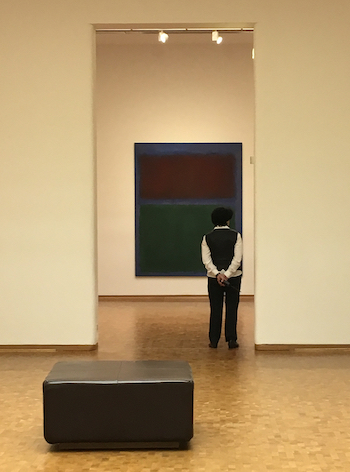
got a question, a comment, or just wanna say hi...?
I'd love to hear from you...
